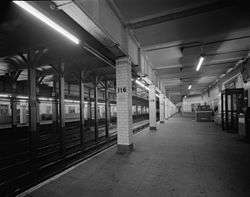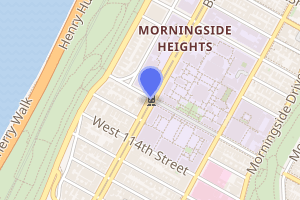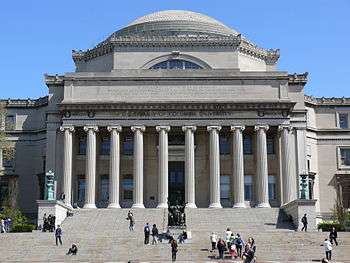116th Street–Columbia University station
116th Street–Columbia University is a local station on the IRT Broadway–Seventh Avenue Line of the New York City Subway. It is located at the intersection of Broadway and 116th Street in Morningside Heights, Manhattan, just outside the west gate to the main campus of Columbia University and the southeast corner of the Barnard College campus. The station is served by the 1 train at all times.
116 Street–Columbia University | |||||||
|---|---|---|---|---|---|---|---|
Platform for uptown trains | |||||||
| Station statistics | |||||||
| Address | West 116th Street & Broadway New York, NY 10027 | ||||||
| Borough | Manhattan | ||||||
| Locale | Morningside Heights | ||||||
| Coordinates | 40.808°N 73.964°W | ||||||
| Division | A (IRT) | ||||||
| Line | IRT Broadway–Seventh Avenue Line | ||||||
| Services | 1 | ||||||
| Transit connections | |||||||
| Structure | Underground | ||||||
| Platforms | 2 side platforms | ||||||
| Tracks | 3 (2 in regular service) | ||||||
| Other information | |||||||
| Opened | October 27, 1904[1] | ||||||
| Station code | 307[2] | ||||||
| Wireless service | |||||||
| Opposite-direction transfer available | Yes | ||||||
| Traffic | |||||||
| Passengers (2019) | 4,380,469[4] | ||||||
| Rank | 112 out of 424[4] | ||||||
| Station succession | |||||||
| Next north | 125th Street: 1 | ||||||
| Next south | Cathedral Parkway–110th Street: 1 | ||||||
| |||||||
| |||||||
| |||||||
116th Street–Columbia University Subway Station (IRT) | |||||||
New York City Landmark No. 1096 | |||||||
| MPS | New York City Subway System MPS | ||||||
| NRHP reference No. | 04001020[5] | ||||||
| NYCL No. | 1096 | ||||||
| Significant dates | |||||||
| Added to NRHP | September 17, 2004 | ||||||
| Designated NYCL | November 24, 1981[6] | ||||||
History
Operation of the first subway began on October 27, 1904, with the opening of the original 28 stations of the New York City Subway from City Hall to 145th Street on the West Side Branch including the 116th Street station.[7]:162–191[8][1]
In 1948, platforms on the IRT Broadway–Seventh Avenue Line from 103rd Street to 238th Street were lengthened to 514 feet (157 m) to allow full ten-car express trains to stop at this station. Previously, the station could only hold six-car local trains. The platform extensions were opened in stages. On April 6, 1948, the platform extension opened for stations from 103rd Street to Dyckman Street, with the exception of 125th Street.[9][10]
In 2002, it was announced that 116th Street would be one of ten subway stations citywide, as well as one of five on the IRT Broadway–Seventh Avenue Line, to receive renovations.[11]
Station layout
| G | Street level | Exit/entrance |
| M | Mezzanine | Fare control, station agent, MetroCard machines |
| P Platform level |
Side platform | |
| Northbound local | ← | |
| Peak-direction express | No regular service | |
| Southbound local | | |
| Side platform | ||

The 116th Street–Columbia University station is laid out in a typical local stop setup. There are two side platforms and three tracks, the center one being an unused express track. The southbound local track is technically known as BB1 while the northbound one is BB4; the BB designation is used for chaining purposes along the Broadway–Seventh Avenue Line from 96th Street to 242nd Street. Although it cannot be accessed at 116th Street–Columbia University, the center track is designated as M. These designations are rarely, if ever, used in ordinary conversation.[12]
There is a mezzanine above the platforms, which contains the fare control area, as well as stairs to the street and both platforms.
Until the 1960s, the station was served by an entrance kiosk similar to the one still in use two miles south at 72nd Street. Today, the concourse is entirely underground, with stairways on either side of Broadway that serve both uptown and downtown trains. In 2004, the station was listed on the National Register of Historic Places.[5]
Exits
The station has four entrance/exit stairs that serve both platforms:
- 2 on the NW corner of Broadway and 116th Street
- 2 on the NE corner of Broadway and 116th Street
There is also an exit-only near the southern end of the northbound platform that leads to the east side of Broadway at 115th Street, outside the Alfred Lerner Hall.[13]
Image gallery
 The above-ground 116th Street entrance, 1910.
The above-ground 116th Street entrance, 1910.- Original tablet and medallions by Heins & LaFarge
- Faience plaque of the number 116
- Faience plaque of the seal of Columbia University
 NW corner stairs
NW corner stairs
References
- "Our Subway Open: 150,000 Try It; Mayor McClellan Runs the First Official Train". The New York Times. October 28, 1904. p. 1. ISSN 0362-4331. Retrieved April 21, 2020.
- "Station Developers' Information". Metropolitan Transportation Authority. Retrieved June 13, 2017.
- "NYC Subway Wireless – Active Stations". Transit Wireless Wifi. Retrieved November 13, 2019.
- "Facts and Figures: Annual Subway Ridership 2014–2019". Metropolitan Transportation Authority. 2020. Retrieved May 26, 2020.
- "New York MPS 116th Street--Columbia University Subway Station (IRT)". Records of the National Park Service, 1785 - 2006, Series: National Register of Historic Places and National Historic Landmarks Program Records, 2013 - 2017, Box: National Register of Historic Places and National Historic Landmarks Program Records: New York, ID: 75313889. National Archives.
- "Interborough Rapid Transit System, Underground Interior" (PDF). New York City Landmarks Preservation Commission. November 24, 1981. Retrieved November 19, 2019.
- Walker, James Blaine (1918). Fifty Years of Rapid Transit — 1864 to 1917. New York, N.Y.: Law Printing. Retrieved November 6, 2016.
- "On this day - New York City subway opens". History Channel. A&E Television Networks. November 6, 2019. Archived from the original on February 8, 2020. Retrieved March 30, 2020.
- Report for the three and one-half years ending June 30, 1949. New York City Board of Transportation. 1949. hdl:2027/mdp.39015023094926.
- "More Long Platforms – Five Subway Stations on IRT to Accommodate 10-Car Trains" (PDF). The New York Times. July 10, 1948. p. 8. ISSN 0362-4331. Retrieved March 27, 2016.
- "Renovation Is Set For 10 Subway Stations". New York Daily News. June 11, 2002. Retrieved January 8, 2018.
- Dougherty, Peter (2006) [2002]. Tracks of the New York City Subway 2006 (3rd ed.). Dougherty. OCLC 49777633 – via Google Books.
- "MTA Neighborhood Maps: Morningside Heights" (PDF). mta.info. Metropolitan Transportation Authority. 2018. Retrieved October 1, 2018.
Further reading
- Stookey, Lee (1994). Subway ceramics : a history and iconography of mosaic and bas relief signs and plaques in the New York City subway system. Brattleboro, Vt: L. Stookey. ISBN 978-0-9635486-1-0. OCLC 31901471.
External links
| Wikimedia Commons has media related to 116th Street – Columbia University (IRT Broadway – Seventh Avenue Line). |
- nycsubway.org – IRT West Side Line: 116th Street
- Station Reporter – 1 Train
- Forgotten NY – Original 28 - NYC's First 28 Subway Stations
- MTA's Arts For Transit – 116th Street–Columbia University (IRT Broadway–Seventh Avenue Line)
- 116th Street entrance from Google Maps Street View
- Platforms from Google Maps Street View






